Karnataka 2nd PUC Economics Important Questions Chapter 5 Government Budget and the Economy
Very Short Answer Type Questions
Question 1.
What is budget?
Answer:
Budget is a financial statement of anticipated revenue and expenditure of the government for the coming financial year.
Question 2.
Give the meaning of deficit budget?
Answer:
If the anticipated expenditure of the government exceeds its anticipated revenue in a year, then it is known as deficit budget.
Question 3.
Name the two accounts of a government budget?
Answer:
The two accounts of a government budget are:
- Revenue account
- Capital account
Question 4.
Give any two examples for direct tax.
Answer:
The two examples for direct tax are:
- Individual Income tax
- Professional tax etc
![]()
Question 5.
Define fiscal policy.
Answer:
According to Arthur Smithies “Fiscal policy is a policy under which the government uses its expenditure and revenues programmes to produce desirable effects and to avoid undesirable effects on the national income, output and employment.
Question 6.
Brief the meaning of progressive tax?
Answer:
A progressive tax is a tax system in which the rate of tax increases as income increases.
Question 7.
State any two sources of non – tax revenue?
Answer:
The two sources of non – tax revenue is:
- Interest receipts
- Profits of Public sector undertakings.
Question 8.
Give the meaning of deficit financing.
Answer:
“Deficit financing is an instrument for fiscal policy to raise the level of output and employment”.
Question 9.
How is primary deficit calculated?
Answer:
Primary deficit can be calculated as: Primary deficit = Fiscal deficit – Interest payments
Question 10.
What is fiscal deficit?
Answer:
Fiscal deficit refers to the difference between the government’s total expenditure and its total receipts excluding borrowings
Question 11.
What is balanced budget?
Answer:
If the anticipated revenue of the govt equals its anticipated expenditure in a year is called balanced budget.
![]()
Question 12.
What is VAT?
Answer:
VAT – Value Added Tax: tax levied on the value added to the product at all stages.
Question 13.
Give the meaning of public expenditure?
Answer:
It refers to the expenditure incurred by the govt for the promotion of economic and social welfare of the people.
Question 14.
What is public revenue?
Answer:
It means the income earned by the govt from both tax and non-tax revenues.
Question 15.
What is disinvestment?
Answer:
Attempting to raise revenues through the sale of shares of public sector undertakings in the open market. This is called disinvestment.
Short Answer Type Questions
Question 1.
Mention any four objectives of the government budget.
Answer:
The four objectives of the government budget are:
- Re-allocation of resources to achieve the desired socio-economic goals.
- Re-distribution of income and wealth
- To prevent income fluctuations
- To control monopolies
![]()
Question 2.
What is tax revenue? Mention its types?
Answer:
A tax is a compulsory payment made by the people to the govemment without expecting any direct returns.
There are 2 types of tax revenue
- Direct tax
- Indirect tax
Question 3.
What do you mean by non-plan revenue expenditure? Give an example.
Answer:
It relates to the expenditure incurred on defence services, law and order, interest payments etc.,
Question 4.
Distinguish between surplus budget and deficit budget.
Answer:
Surplus Budget:
If the anticipated revenue of the government exceeds its anticipated expenditure in a year, then it is known as Surplus Budget.
Deficit Budget:
If the anticipated expenditure of the government exceeds its anticipated revenue in a year then it is known as deficit budget.
Question 5.
Differentiate between direct and indirect tax
Answer:
Direct tax:
The taxes levied on the income and wealth of the people are called direct taxes. They include:
(a) Personal Income tax
(b) Corporation tax
Indirect Tax:
The tax levied on the goods and services are called indirect taxes. They include
(a) Central excise duties
(b) Customs duties
![]()
Question 6.
What are the major components of non-plan revenue, expenditure of the government in developing countries?
Answer:
The major components of non-plan revenue expenditure of the government in developing countries are:
(a) Expenditure on defence service
(b) Interest payments on borrowings
(c) Subsidies constitute
Question 7.
What are the uses of tax systems as an instrument of fiscal policy in India?
Answer:
The uses of tax system as an instrument of fiscal policy in India
- To mobilize revenue and check unwanted expenditure,
- To affect changes in the pattern of distribution of income and wealth.
- To use as a weapon to control inflation and deflation.
Question 8.
Name any four objectives of fiscal policy?
Answer:
The four objectives of fiscal policy are:
- Mobilisation of resources to finance development projects
- To accelerate the growth of public sector
- To reduce regional disparities, poverty and unemployment.
- For optimum utilisation of resources.
Question 9.
Give any four suggestions to reduce market loans in India?
Answer:
The four suggestions to reduce market loans in India, they are:
- The government of RBI should be integrated with those of the government
- Utilization of the resources generated through the sale of a part of the vast real estate
- Utilization of the resources generated through disinvestment
- A substantial part of gold reserves created by gold seized from smuggling and other illegal activities should be auctioned
Question 10.
How can a deficit be reduced?
Answer:
The govt of India can reduce deficit through following ways:
- Increasing direct tax collection more effectively
- Curtailing government expenditure through efficient and better administration
- Attempting to raise revenues through the sale of shares of public sector undertakings in the open market.
Long Answer Type Questions
Question 1.
Write a note on the revenue account of the government budget?
Answer:
Revenue Account comprises
- Revenue Receipts
- Revenue Expenditure.
1. Revenue Receipts:
Refers to revenue earned by the government from tax and non – tax sources.
(a) Tax revenue consists of the proceeds of taxes and other duties levied by the government. “A tax is a compulsory payment made by the people to the government without expecting any direct returns.
(b) Non-tax revenue: Revenue collected from sources other than tax sources is non – tax revenue. Its consists of fees, fines and grant-in-aid from foreign countries.
2. Revenue expenditure:
The revenue expenditure relates to the expenditure incurred on implementation of economic plans, government provisions etc.
(a) Plan revenue expenditure:
Plan revenue expenditure relates to the expenditure incurred on implementation of economic plans, the government provisions etc.
(b) Non – plan revenue expenditure:
Non-plan revenue expenditure relates to the expenditure incurred on defence services, law and order, Interest payments etc.
![]()
Question 2.
Explain the role of public expenditure as an instrument of fiscal policy?
Answer:
The role of public expenditure as an instrument of fiscal policy:
Public expenditure refers to the expenditure incurred by the government for the promotion of the economic and social welfare of the people.
- Public expenditure has several effects in income, output and employment. Therefore, it is regarded as a significant instrument in the determination of economic development of a country.
- The public expenditure is important in those sectors where private spending is either less or nil.
- Public expenditure plays important role in development of infrastructural facilities like industries, irrigation and power projects etc.
- Besides government has to incur expenditure on defence, administration, tax collection, external affairs etc.
- The pulbic expenditure is also important for
(a) Participation in material production
(b) Provision of social services
(c) Maintenance and enforcement of law and order.
Question 3.
Does public debt impose a burden? Explain.
Answer:
Public debt refers to borrowings of the government to meet budget deficits. It is used as an effective instrument of fiscal policy to control inflation or deflation.
- When the government goes on borrowing, debts accumulates and burden of interest increases.
- Then the government has to impose higher taxes on the people.
- Public debt will reduce disposable income, consumption, savings and national Income.
- The public debt increases “burden” on the future generation.
- Internal debt is manageable but where as external debt it seriously affects the country development.
- And public debt should be reduced substantially to avoid collapse of the fiscal system.
Question 4.
Explain the types of Budget deficits?
Answer:
The Budget deficits are of three types:
- Revenue deficit
- Fiscal deficit
- Primary deficit
1. Revenue deficit:
Revenue deficit refers to the excess of the government’s Revenue expenditure over its revenue receipts.
It can be expressed as Revenue deficit=Revenue expenditure – Revenue Receipts.
2. Fiscal deficit:
Fiscal deficit refers to the excess of government’s total expenditure over its total revenue.
It can be expressed as Fiscal deficit = Total expenditure – Revenue Receipts + Non – Debt receipts.
3. Primary deficit:
Primary deficit refers to the excess of fiscal deficit over Interest payments.
It can be expressed as Primary deficit = Fiscal deficit – Interest payments.
Question 5.
Explain the components of government budget?
Answer:
The components of government budget are:
(A) Revenue account
(B) Capital account
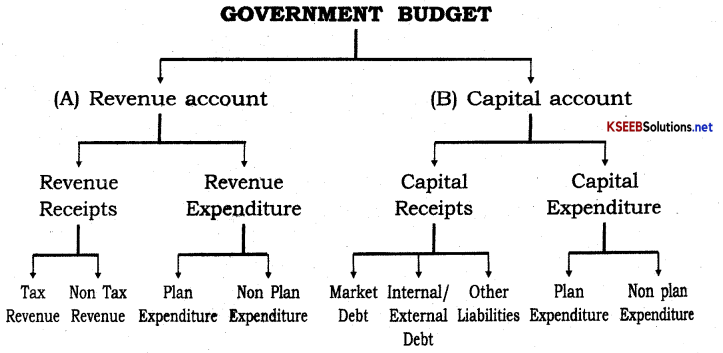
(A) Revenue Account:
- Revenue Receipts
- Revenue Expenditure
1. Revenue Receipts:
Refers to revenue earned by the government from tax and non – tax sources.
(a) Tax revenue consists of the proceeds of taxes and other duties levied by the government. “A tax is a compulsory payment made by the people to the government without expecting any direct returns”.
(b) Non-tax revenue: Revenue collected from sources other than tax sources is non – tax revenue. Its consists of fees, fines and grant-in-aid from foreign countries.
2. Revenue expenditure:
The revenue expenditure relates to the expenditure incurred on implementation of economic plans, government provisions etc.
(a) Plan revenue expenditure:
Plan revenue expenditure relates to the expenditure incurred on implementation of economic plans, the government provisions etc.
(b) Non – plan revenue expenditure: Non-plan revenue expenditure relates to the expenditure incurred on defence services, law and order, Interest payments etc.
(B) CapitalAccount:
- Capital Receipts
- Capital Expenditure
1. Capital Receipts:
Capital receipts are those receipts of the government that create liability [ex: borrowings] or reduce financial assets [ex. disinvestment].
2. Capital expenditure:
Capital expenditure refers to the expenditure incurred on the acquisition of assets such as land, building, machinery, loans and advances, etc.
The capital expenditure is also categoriged as:
(a) Plan capital expenditure: The plan capital expenditure relates to expenditure incrurred for creating permanent revenue yielding assets, ex: Agriculture, transport, industries etc.
(b) Non – plan capital expenditure: Non plan capital expenditure relates to expenditure incurred on compensation, rehabilitation facilities during natural calamities, and it also includes repayment of loans.
![]()
Question 6.
Describe the instruments of fiscal policy.
Answer:
The instruments of fiscal policy are:
- Public expenditure
- Public revenue
- Public debt
- Deficit financing
1. Public expenditure:
Public expenditure refers to the expenditure incurred by the government for the promotion of the economic and social welfare of the people.
Public expenditure has several effects on income, output and employment. Therefore, it is regarded as a significant instrument in the determination of the economic development of a country.
The public expenditure becomes important for the development of infrastructural facilities, by govt like industries, irrigation and power projects, public health, education, transportation, housing etc.
2. Public revenue:
Public revenue refers to the income earned by the government from both tax and non – tax revenues. A suitable tax policy is always regarded as an important technique in bringing about economic stability. Because changes in the rates of taxes will course change in the level of disposable income and consumption expenditure of the people. Generally, Government generates revenues through tax and non-tax sources
3. Public debt:
Public debt refers to the borrowings of the goverment to meet budget deficits. It is used as an effective instrument of fiscal policy to control inflation or deflation. Public debt and public deficit are inter related. When the government goes on borrowing , debts accumulates and burden of interest increases. This may result in imposing higher rate of taxes on the people by government. Consequently, the growth of the economy will be retarded.
4. Deficit financing:
Deficit financing is the policy of estimation of exessive expenditures by the government over its revenue deliberately to set the economy on the path of economic growth.
In brief, it refers to higher expenditure over receipts Deficit financing is also known as budgetary deficit.
Deficit financing leads to an increase in demand, investment, production, employ and income and even it helps in accelarating the pace of economic growth in the economy.
Exercises
Question 1.
Explain why public goods must be provided by the government.
Answer:
A good that is non-rival and non-excludable is referred to as public good. Non-rival means that consumption by one individual does not affect the consumption of another individual. Whereas, non-excludable implies that no individual can be excluded from using the good. For example, parks, roads, national defence, etc.
These goods must be provided by the government because of the following reasons:
- The benefits of public goods can be easily enjoyed by anyone without affecting the consumption of other individuals. There arises market failure.
- No individual can be excluded from using public goods as it is available to all. The link between the producer and the consumer becomes non-functional, necessitating government interference through public provisions.
![]()
Question 2.
Distinguish between revenue expenditure and capital expenditure.
Answer:
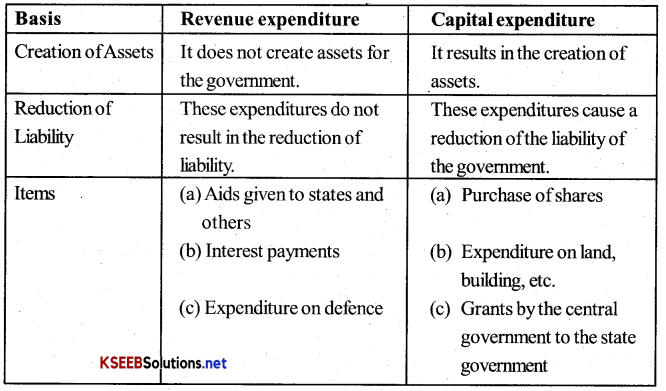
Question 3.
‘The fiscal deficit gives the borrowing requirement of the government’. Elucidate.
Answer:
Fiscal deficit is the excess of total expenditure over total receipts. That is, when total government expenditure is greater than total government receipts, the government faces fiscal deficit.
The fiscal deficit is estimated as:
Total Expenditure (revenue + capital) – Total Receipts (excluding borrowings). The fiscal deficit gives an indication to the government about the total borrowing requirements from all sources. The fiscal deficit can be financed through domestic borrowings and/or borrowings from abroad. A greater fiscal deficit implies greater borrowings by the government.
Question 4.
Give the relationship between the revenue deficit and the fiscal deficit.
Answer:
The relationship between the revenue deficit and the fiscal deficit can be explained through the following points:
1. Revenue deficit is the difference between the government’s revenue expenditures and the government’s receipts.
Revenue deficit = Revenue expenditures – Revenue receipts
On the other hand, the fiscal deficit is the difference between the total expenditure and the total receipt of the government. Fiscal deficit =Total Expenditure – Total Receipts (excluding borrowings)
2. The term ‘ fiscal deficit ’ is used in a broader sense than the term ‘revenue deficit’.
3. As the revenue deficit increases, the proportion of fiscal deficit also increases.
Question 5.
Suppose that for a particular economy, investment is equal to 200, government purchases are 150, net taxes (that is lump-sum taxes minus transfers) is 100 and consumption is given by ‘C= 100 + 0.75F
(a) What is the level of equilibrium income?
(b) Calculate the value of the government expenditure multiplier and the tax multiplier.
(c) If government expenditure increases by 200, find the change in equilibrium income.
Answer:
I = 200
G = 150
T =100
C = 100 +0.75 Y
So, C (Autonomous consumption) = 100 And, MPC (c) = 0.75
(a) Equilibrium level of income
= \(\frac{1}{1-0.75}\) (100-0.75 × 100 + 200 + 150) 1-0.75v
= \(\frac{1}{0.25}\) × 375
= Rs. 1500
(b) Government expenditure multiplier
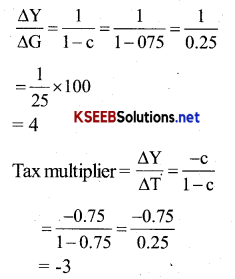
(c) Δ G = 200
New equilibrium income
= \(\frac{1}{1-c}\) [C – cT + 1 + G + ΔG]
= \(\frac{1}{1-0.75}\) [100-0.75 × 100 + 200 + 150 + 201
= \(\frac{1}{0.25}\) × 575
= \(\frac{100 \times 575}{25}\)
= Rs 2300
‘ Therefore, change in equilibrium income = 2300- 1500 = Rs. 800
![]()
Question 6.
Consider an economy described by the following functions: C=20+0.80Y, I = 30, G = 50, TR = 100
(a) Find the equilibrium level of income and the autonomous expenditure multiplier in the model,
(b) If government expenditure increases by 30, what is the impact on equilibrium income?
(c) If a lump-sum tax of 30 is added to pay for the increase in government purchases, how will equilibrium income change?
Answer:
I = 30 c = 0.80
G =50
T = 100
Equilibrium level of income
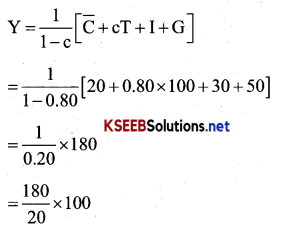
= 900
Expenditure multiplier = \(\frac{1}{1-c}\)
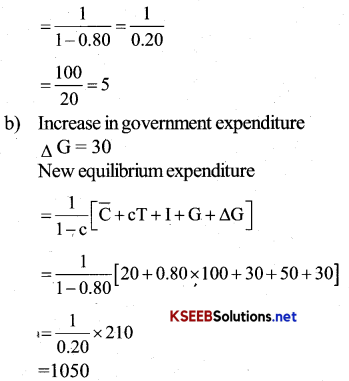
Equilibrium level of income inceases by 150 (1050 – 900)
(c) Tax multiplier = \(\frac{-c}{1-c}\)
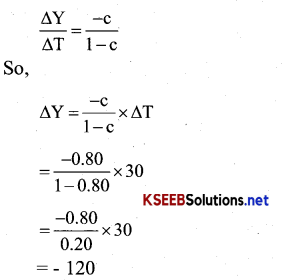
Question 7.
In the above question, calculate the effect on output of a 10 per cent increase in transfers, and a 10 per cent increase in lump-sum taxes. Compare the effects of the two.
Answer;
MPC = 0.80
C=20
I = 30
G = 50
TR = 100
ATR = 10
Equilibrium level of income

= Rs. 940
change in income = 940 – 900 = Rs 40
increase in lump-sum tax ΔT= 10
change in income = Δ T = \(\frac{-c}{1-c}\)
= -10 × \(\frac{0.80}{0.20}\)
= -10 × 4
= -40
From the above results, we can conclude that increase of 10 percent in transfers will raise the income by 40%.
Question 8.
We suppose that C = 70 + 0.70Y D, I = 90, G = 100, T = 0.10Y
(a) Find the equilibrium income.
(b) What are tax revenues at equilibrium
Income? Does the government have a balanced budget?
Answer:
(a) C = 70 + 0.70 YD
I = 90
G= 100
T=0.10y
Y = C + I + G
Y = 70 + 0.70Y + 90 + 100
Y = 70 + 0.70YD + 190
Y = 70 + 0.70 (Y-T) + 190
Y= 70 + 0.70Y- 0.70 × 0.10 Y+190
Y = 70 + 0.70Y – 0.07Y + 190
Y = 70 + 0.63Y + 190
Y = 260 + 0.63Y Y – 0.634 = 260
0.37Y = 260
Y = \(\frac{260}{0.37}\)
Y = 702.7
(b) T = 0.10Y
= 0.10 × 702.7
= 70.27
Government expenditure = 100
Tax revenue = 70.27
As, G > T, Government has a deficit budget, not a balanced budget.
Question 9.
Suppose marginal propensity to consume is 0.75 and there is a 20 per cent proportional income tax. Find the change in equilibrium income for the following
(a) Government purchases increase by 20
(b) Transfers decrease by 20.
In case of proportional taxes
Answer:
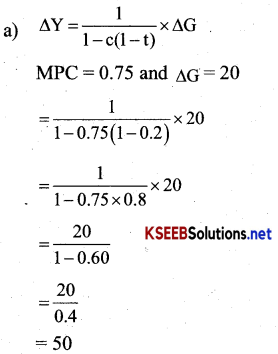
(b) Transfer decreases by 20
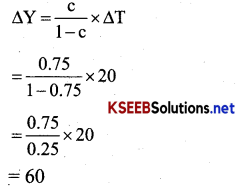
![]()
Question 10.
Explain why the tax multiplier is smaller in absolute value than the government expenditure multiplier.
Answer:
The tax multiplier is smaller in absolute value than the government expenditure multiplier, as the government expenditure affects the total expenditure and taxes through the multiplier. Tax multiplier also influences disposable income that affects the overall consumption level.
The reason is explained through the following example.
Let’s assume MPC be to 0.80.
= \(\frac{1}{1-0.80}\)
Then, the government expenditure multiplier = \(\frac{1}{1-c}\)
\(\frac{100}{0.20}\) = 5
Tax multiplier = \(\frac{-c}{1-c}=\frac{-80}{1-0.80}\)
= \(\frac{-0.80}{0.20}\)
= – 4
This shows that the government expenditure multiplier is more than the tax multiplier.
Question 11.
Explain the relation between government deficit and government debt.
Answer:
The relation between government deficit and government debt can be explained through the following points.
- The government deficit is the excess of total expenditure over total receipt of the government; whereas, government debt is the amount- of liability, owed by the government to the public, foreign and other institutions.
- The term government deficit implies an increase in the debt of the government. In other words, if the government continues to borrow to finance deficit, it leads to additional debt.
Question 12.
Does public debt impose a burden? Explain.
Answer:
Government debt or public debt refers to the amount or money that a central government owes. This amount may be borrowings of the government from banks, public financial institutions and from other external and internal sources. Public debt definitely imposes a burden on the economy as a whole, which is described through the following points.
1. Adverse effect on productivity and investment: A government may impose taxes or get money printed to repay the debt. This however reduces the peoples’ ability to work, save and invest, thus hampering the development of a country,
2. Burden on younger generations: The government transfers the burden of reduced consumption on future generations. Higher government borrowings in the present leads to higher taxes levied in future in order to repay the past obligations. The government imposes taxes on the younger generations, lowering their consumption, savings and investments.
Hence, higher public debt has negative effect on the welfare of the younger generations.
3. Lowers the private investment: The government attracts more investment by raising rates of interests on bonds and securities. As a result/a major part of savings of citizens goes in the hands of the government, thus crowding out private investments.
4. Leads to the drain of National wealth: The wealth of the country is drained out at the time of repaying loans taken from foreign countries and institutions.
Question 13.
Are fiscal deficits inflationary?
Answer:
Fiscal deficits are not necessarily inflationary, though, they are generally regarded as inflationary. When the government expenditure increases and tax reduces, there is a government deficit and there will be a corresponding increase in the aggregate demand. However, the firms might not be able to meet the growing demands, forcing the price to rise. Hence fiscal deficits are inflationary in this sense.
But on the other hand, initially, if the resources are underutilized (due to insufficient demand) and output is below frill employment level, then with the increase in government expenditure, more factor resources will be employed to cater to the increasing demand without exerting much pressure on the price to rise. In this situation, a high fiscal deficit is accompanied by high demand, greater output level and a lesser inflationary situation. Hence, whether the fiscal deficits are inflationary or not depends on how close is the original output level to the full employment level.
![]()
Question 14.
Discuss the issue of deficit reduction.
Answer:
The ways of government budget deficit reduction are the following:
1. Decreasing expenditure
(a) The expenditure of government should be decreased by making government activities more planned and effective.
(b) The government can encourage the private sector to undertake capital projects.
2. Increasing revenue
(a) Higher taxes imply higher income earned by the government. Also, new taxes may add to the revenues of the government.
(b) The government can sell shares of Public Sector Undertakings (PSU disinvestment) to increase its revenue.